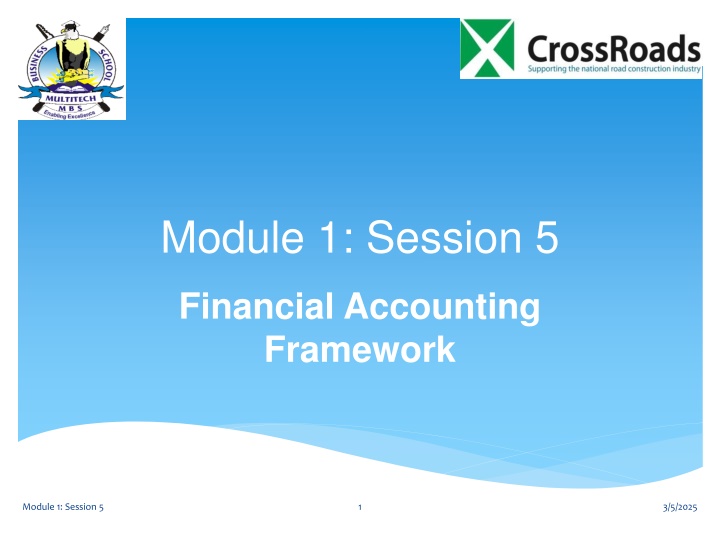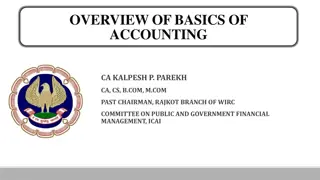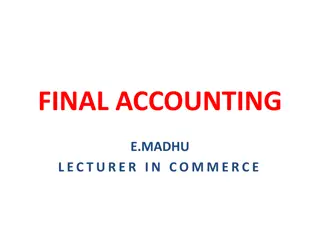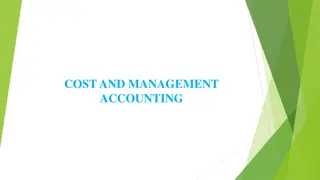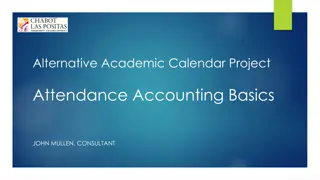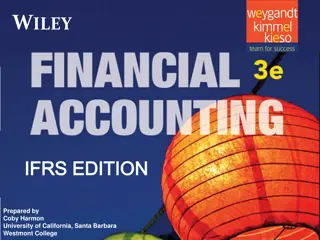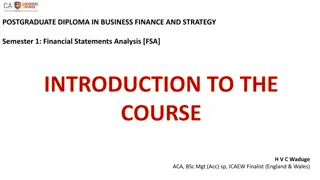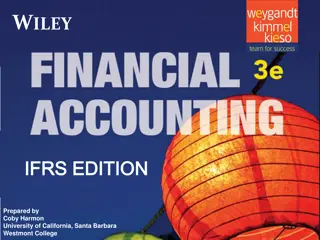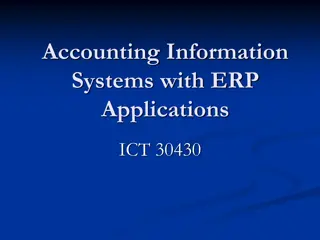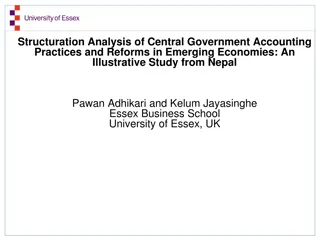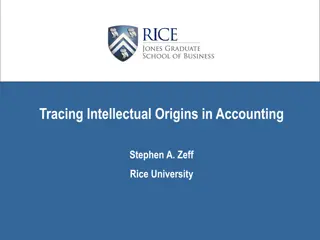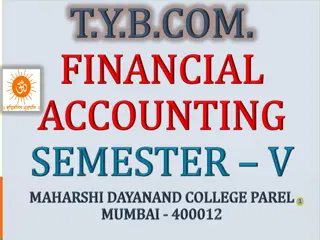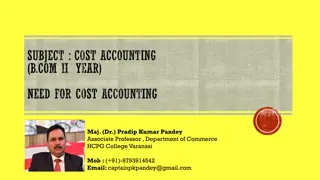Financial Accounting Fundamentals
Delve into the nature of financial transactions, double entry system, internal controls, financial documents, and dangers of poor accounting practices. Understand the classification of transactions, current and capital transactions, and the bookkeeping process to create financial statements.
Download Presentation

Please find below an Image/Link to download the presentation.
The content on the website is provided AS IS for your information and personal use only. It may not be sold, licensed, or shared on other websites without obtaining consent from the author.If you encounter any issues during the download, it is possible that the publisher has removed the file from their server.
You are allowed to download the files provided on this website for personal or commercial use, subject to the condition that they are used lawfully. All files are the property of their respective owners.
The content on the website is provided AS IS for your information and personal use only. It may not be sold, licensed, or shared on other websites without obtaining consent from the author.
E N D
Presentation Transcript
Module 1: Session 5 Financial Accounting Framework Module 1: Session 5 1 3/5/2025
Purpose of Session Introduce the nature of financial transactions and the double entry system (income and expenditure, assets and liabilities) Outline basic internal controls Introduce basic financial documents, records and books Identify dangers of not maintaining proper accounting records and internal controls Module 1: Session 5 2 3/5/2025
Nature of Financial Transactions A financial transaction occurs when there is a monetary exchange of goods, service or legal promises between one party and another. A business transaction can be current or capital. Current transactions that bring in money are revenue transactions while those that take it out are expenses. Capital transactions are significant expenses to benefit a business over a period exceeding one financial year. In a financial transaction one party receives and another gives value Module 1: Session 5 3 3/5/2025
Double entry Financial transactions of a business are recorded in a book called a general ledger. Every transaction is recorded twice in suitable accounts, a debit and a credit, that are self checking one to indicates who takes and the other who gives value. An account is a collection of similar transactions that are recorded in a ledger. A Ledger therefore consists of many accounts that classify the transactions of a business. Module 1: Session 5 4 3/5/2025
Book Keeping Process Periodically the transactions in an account are totaled up and netted to give a balance. A list of all the balances in the ledger is called a trial balance. Because of the double entry rule a list of all balances in the ledger totals zero (all debits equal all credits). Debits balances comprise of expenses and assets while credits comprise of revenue and liabilities. The list of balances is summarized and analysed to make financial statements. Module 1: Session 5 5 3/5/2025
Classification of transactions Current transactions Income Expenditure Inventory Accounts receivables and accounts payables Capital transactions Assets Long term liabilities Module 1: Session 5 6 3/5/2025
Classification of current transactions (income statement) Expenditure (Debits) Income (Credits) Materials Labor Maintenance Machine hire Fuel Telephone Stationery Site rent Completed construction works Hire out of equipment Sale of fabricated items e.g. blocks, pavers etc. Module 1: Session 5 7 3/5/2025
Classification of balance sheet items Assets (debits) Liabilities (credits) Long term liabilities such as Capital Retained earnings Term loans Current liabilities such as Trade suppliers/accounts payable Utility bills Unpaid wages Bank overdraft Fixed assets such as Land Equipment Motor vehicles Current assets such as: Inventory of raw materials Consumable stores Accounts receivable Bank balances and cash Module 1: Session 5 8 3/5/2025
What are internal controls (IC) The whole system of controls, established and approved by management to ensure orderly operations and to safeguard the resources/assets IC are exhibited in many forms e.g. physical controls, written or not; others formal and some informal IC are dependent on and vary with the purpose of the organization IC basically safeguard the resources of the entity, no matter its purpose. Module 1: Session 5 9 3/5/2025
Usefulness of IC to managers 1) Assist to operate in an orderly manner 2) Prevents error and defalcation 3) Detects error and defalcation 4) Safeguards the assets of the Organization 5) Gives assurance over the integrity of financial reports Module 1: Session 5 10 3/5/2025
Basic Internal Controls Physical controls: Limiting access to resources, data, records or information Recording such access. Administrative controls: 1) Having a mission, objectives and targets 2) Establishing policies, rules and regulations 3) Having structures, hierarchy and delegation of authority 4) Appointments of persons to offices (staffing) 5) Job profiling Module 1: Session 5 11 3/5/2025
Types of Financial Internal Controls Financial controls: 1) Segregation of duty. 2) Documentation. 3) Internal checks. 4) Testing arithmetical accuracy. 5) Reporting. 6) Reconciliation of information from different data bases. 7) Analysis of financial information. 8) Verification and audits. 9) Audit trailing. Module 1: Session 5 12 3/5/2025
List of basic financial documents Local Purchase Order Materials Received Note Materials Delivery Note Invoice A certificate A receipt A cash sale A pro forma invoice/quotation Bill of quantities (BOQ) Payment voucher A cheque Electronic transfer forms (ETF) Module 1: Session 5 13 3/5/2025
List of common Accounting Books Cashbook Purchases journal Sales journal Nominal Journal Nominal Ledger Subsidiary Ledgers: 1) Purchases Ledger 2) Sales Ledger 3) Stock Ledger Module 1: Session 5 14 3/5/2025
Statements generated from accounting records Statement of trading performance (Income) Statement of position (Balance Sheet) Statement of transformation (generation and investment of funds statement of cash flow) Module 1: Session 5 15 3/5/2025
Dangers of not Maintaining Proper Accounting Records The legal requirement for directors to keep proper books of accounts that form a basis for financial statements that are true and fair is violated. A legal requirement for directors to put in place adequate internal controls that safeguard the assets of the business is also violated. Inaccurate or incomplete financial statements are produced due to error or defalcation Module 1: Session 5 16 3/5/2025
Dangers of not Maintaining Proper Accounting Records Poor financial or uncompetitive bids Problems with tax authorities Fraud or misappropriation of business resources Inability to relate with funding institutions Inability to monitor business performance Misrepresentation of true position of the business Module 1: Session 5 17 3/5/2025
Group assignment 1. Justify the keeping of proper accounting records and outline with examples (ref. to case study) the major classes of business transactions. 2. List the major accounting documents and records used in road construction. Comment on the challenges posed by computers. 3.State the major categories of financial internal controls and Identify core Internal controls over site purchase (or labor) transactions. 4.Explain to Munaku the dangers of not maintaining proper accounting records 5.Identify internal control weaknesses in Munaku Contractors and list the dangers of maintaining weak internal controls. Module 1: Session 5 18 3/5/2025
Thank you END Q& A Module 1: Session 5 19 3/5/2025
